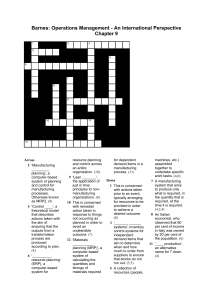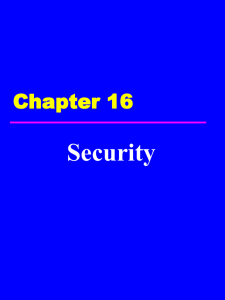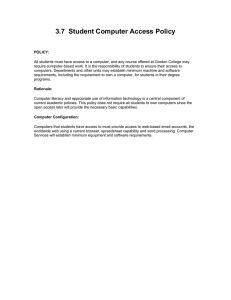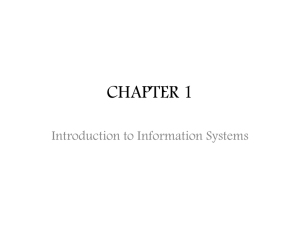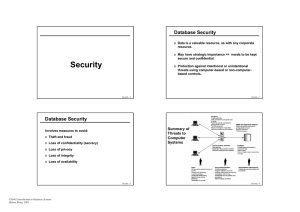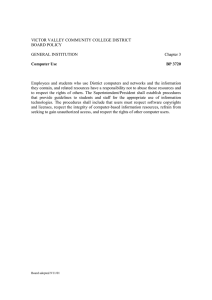Minggu 7, Pertemuan 13 Security Matakuliah : T0206-Sistem Basisdata
advertisement
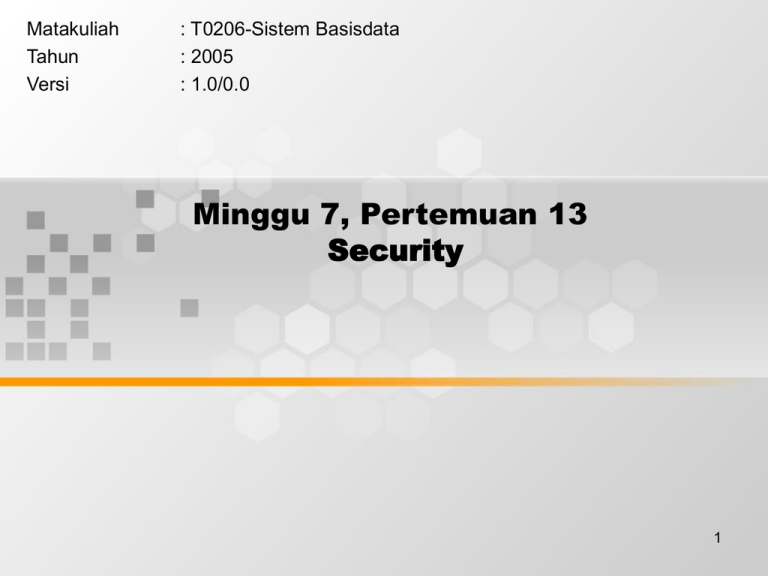
Matakuliah Tahun Versi : T0206-Sistem Basisdata : 2005 : 1.0/0.0 Minggu 7, Pertemuan 13 Security 1 Learning Outcomes Pada akhir pertemuan ini, diharapkan mahasiswa dapat dapat menjelaskan berbagai aspek dalam database security dan privasi (C2) 2 Outline Materi • Scope of database security. • Why database security is a serious concern for an organization. • Type of threats that can affect a database system. • How to protect a computer system using computer-based controls. • Security measures provided by Microsoft Access and Oracle DBMSs. • Approaches for securing a DBMS on the Web. 3 Database Security • Data is a valuable resource that must be strictly controlled and managed, as with any corporate resource. • Part or all of the corporate data may have strategic importance and therefore needs to be kept secure and confidential. 4 Database Security (cont.) • Mechanisms that protect the database against intentional or accidental threats. • Security considerations do not only apply to the data held in a database. Breaches of security may affect other parts of the system, which may in turn affect the database. 5 Database Security (cont.) • Involves measures to avoid: – Theft and fraud – Loss of confidentiality (secrecy) – Loss of privacy – Loss of integrity – Loss of availability 6 Database Security (cont.) • Threat – Any situation or event, whether intentional or unintentional, that will adversely affect a system and consequently an organization. 7 Summary of Threats to Computer Systems 8 Typical Multi-User Computer Environment 9 Countermeasures – Computer-Based Controls • Concerned with physical controls to administrative procedures and includes: – Authorization – Views – Backup and recovery – Integrity – Encryption – RAID technology 10 Countermeasures – Computer-Based Controls • Authorization – The granting of a right or privilege, which enables a subject to legitimately have access to a system or a system’s object. • Authentication – A mechanism that determines whether a user is who he or she claims to be. 11 Countermeasures – Computer-Based Controls (cont.) • View – Dynamic result of one or more relational operations operating on the base relations to produce another relation. – A virtual relation that does not actually exist in the database, but is produced upon request by a particular user, at the time of request. 12 Countermeasures – Computer-Based Controls (cont.) • Backup – Process of periodically taking a copy of the database and log file (and possibly programs) to offline storage media. • Journaling – Process of keeping and maintaining a log file (or journal) of all changes made to database to enable effective recovery in event of failure. 13 Countermeasures – Computer-Based Controls (cont.) • Integrity – Prevents data from becoming invalid, and hence giving misleading or incorrect results. • Encryption – The encoding of the data by a special algorithm that renders the data unreadable by any program without the decryption key. 14 RAID (Redundant Array of Independent Disks) Technology • Hardware that the DBMS is running on must be fault-tolerant, meaning that the DBMS should continue to operate even if one of the hardware components fails. • Suggests having redundant components that can be seamlessly integrated into the working system whenever there is one or more component failures. 15 RAID Technology (cont.) • Main hardware components that should be fault-tolerant include disk drives, disk controllers, CPU, power supplies, cooling fans. • Disk drives are most vulnerable components with shortest times between failure of any of the hardware components. 16 RAID Technology (cont.) • One solution is to provide a large disk array comprising an arrangement of several independent disks organized to improve reliability and increase performance. 17 RAID Technology (cont.) • Performance is increased through data striping: the data is segmented into equal-size partitions (the striping unit), which are transparently distributed across multiple disks. • Reliability is improved through storing redundant information across the disks using a parity scheme or an errorcorrecting scheme. 18 Security in Microsoft Access DBMS • Provides two methods for securing a database: – setting a password for opening a database (system security); – user-level security, which can be used to limit the parts of the database that a user can read or update (data security). 19 Securing the DreamHome Database Using a Password 20 User and Group Accounts Dialog Box for the DreamHome Database 21 User and Group Permissions Dialog Box 22 Creation of a New User with Password Authentication Set 23 Log on Dialog Box 24 Setting the Permissions 25 DBMSs and Web Security • Internet communication relies on TCP/IP as the underlying protocol. • However, TCP/IP and HTTP were not designed with security in mind. Without special software, all Internet traffic travels ‘in the clear’ and anyone who monitors traffic can read it. 26 DBMSs and Web Security (cont.) • Must ensure while transmitting information over the Internet that: – – – – – inaccessible to anyone but sender and receiver (privacy); not changed during transmission (integrity); receiver can be sure it came from sender (authenticity); sender can be sure receiver is genuine (non-fabrication); sender cannot deny he or she sent it (non-repudiation). • Must also protect information once it has reached Web server. 27 DBMSs (cont.) and Web Security • Download may have executable content, which can perform following malicious actions: – – – – – – – Corrupt data or execution state of programs. Reformat complete disks. Perform a total system shutdown. Collect and download confidential data. Usurp identity and impersonate user. Lock up resources. Cause non-fatal but unwelcome effects. 28
